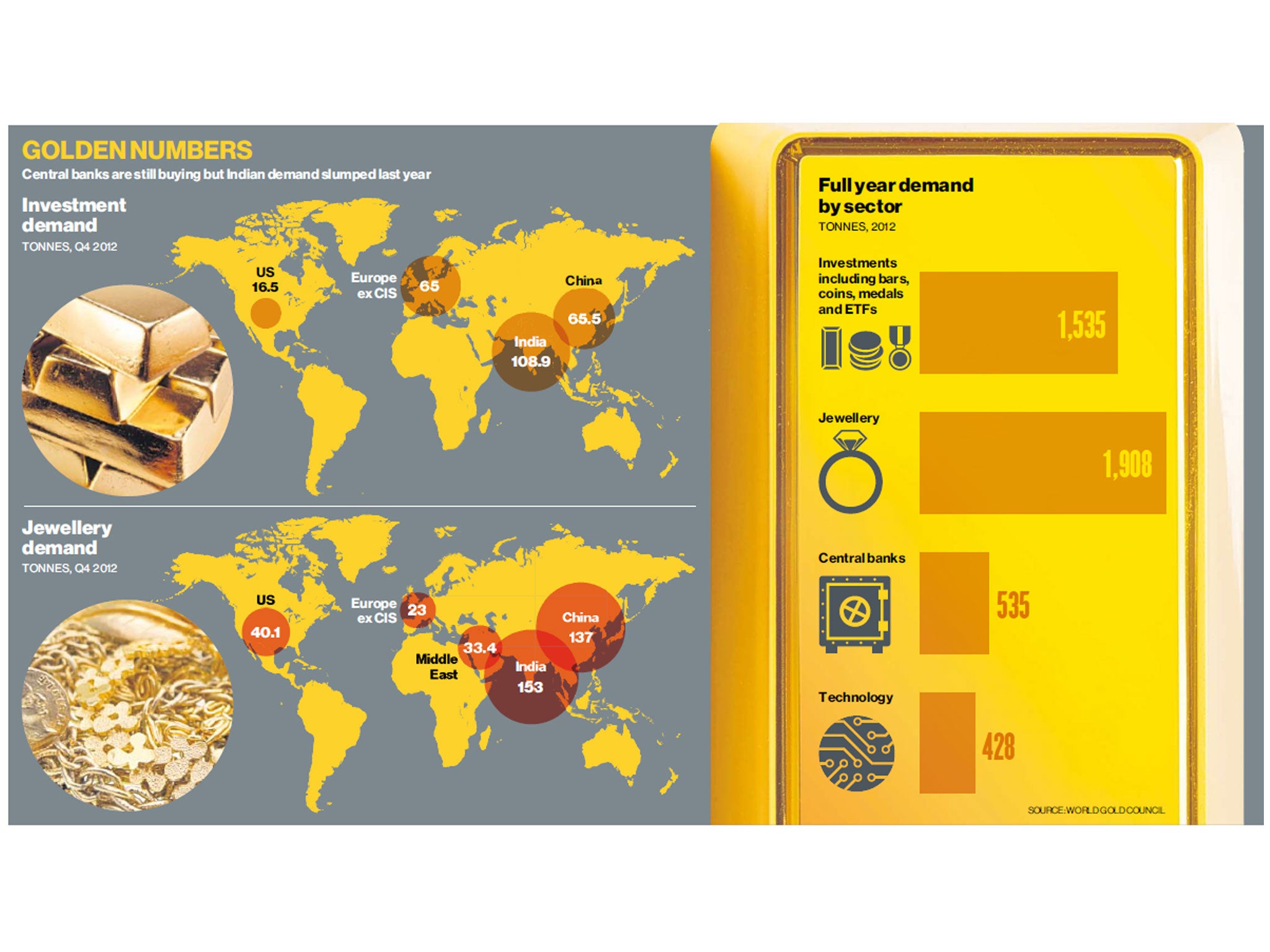Still worth taking a shine to gold
The precious metal may have lost some of its lustre as investors rediscover their taste for shares – but don't write it off just yet

Is gold about to lose its shine? For a precious but pretty useless metal with few applications beyond the spheres of jewellery and investment, it has been in hot demand for the past 12 years. As the Chancellor, George Osborne, never tires of pointing out, Britain missed the start of a decade-long bull market in gold because his predecessor, Gordon Brown, decided to sell about 60 per cent of the UK's reserves soon after Labour took office.
He sold off 470 tons at an average of $250 an ounce, close to the bottom of the market. Today, it trades at $1,648 an ounce, and it hit a record high of $1,920 in August 2011 when the latest storms in the eurozone crisis sent investors scurrying into safe havens.
As a store of wealth, gold doesn't offer any returns – usually making it an unattractive investment – but it looks appealing when countries appear to be teetering on brink of bailouts or default, and is also the traditional hedge against inflation. The industry-funded World Gold Council (WGC) estimates Mr Brown's disastrous decision cost the UK around £20bn as the price of the metal soared higher. But the council's latest study of the market found that demand actually fell last year for the first time since 2009, by 4 per cent to 4,405 tons – even though, measured by value, trading hit an all-time high of $236bn (£152bn). Meanwhile, the price is down 1.4 per cent so far this year after posting its biggest quarterly drop since 2008 in the last three months of 2012. Analysts at Credit Suisse and Goldman Sachs have forecast a turn in gold's bull cycle this year. Is the precious metal's run coming to an end?
The recent bullish run in stock markets, underlined by the FTSE 100 index's best January for 24 years, suggests so as investors regain their appetite for risk, and seek to sink their cash into dividend-bearing shares. Thanks to the explicit pledges of support from the European Central Bank, the sovereign debt of eurozone strugglers such as Spain and Italy have also been snapped up this year. "Gold prices will continue to struggle to regain investor confidence as cautious market participants stay away," says the VTB Capital commodities analyst Andrey Kryuchenkov. The Credit Suisse analyst Tom Kendall adds: "Attention is much more focused elsewhere at the moment."
But as central banks including the Bank of England, the US Federal Reserve and the Bank of Japan rely on the printing presses to boost flagging economic performance, other worried central banks around the world have dived into the gold market.
Reserve banks in emerging economies such as China, India, Russia, India and Mexico are seeking to protect themselves against the devaluation of their currency holdings amid simmering tensions over another bout of "currency wars".
Buying by various central banks hit a 48-year high of 534.6 tons in 2012.Marcus Grubb, WGC's managing director, expects the official sector to match last year's buying in 2013, partly because monetary easing by developed countries was undermining confidence.
"Emerging-country central banks regard quantitative easing policies as divisive and believe they affect the value of the assets that they hold – the dollar and euro, for example," he says. "They are diversifying away from traditional currencies and buying gold as a hedge."
Central bank purchases, though massively higher, failed to offset a 12 per cent slump in demand from India last year, the world's biggest market for jewellery. But the WGC puts this down to a blip, rather than the beginning of a downward trend. This is because the Indian government increased import duties on gold to 4 per cent from 1 per cent last year, triggering strikes among jewellers and hitting the market. By the end of the year, India's love of gold re-emerged as demand for gold jewellery rose 35 per cent year-on-year in the final quarter of 2012. Although China suffered an economic wobble (by recent standards) in the middle of last year, the world's second-biggest gold buyer behind India also saw demand recovering again by the end of 2012 despite the first decline in jewellery demand for a decade across 2012 overall.
Although Mr Grubb doesn't predict stellar rises for gold this year, he is far from forecasting the sliding prices that might be associated with recovering equity markets. First, the fundamentals of supply and demand: 4,400 tons were bought last year, but only 2,800 actually mined, with the shortfall made up by recycling.
Then there's the money printing, boosting the prices of all assets, including gold. Mr Grubb adds: "Some people have lost sight of the fact that we are in the middle of a massive economic experiment. This is a new cycle."
Investors may be infatuated with shares for the time being, but the decade-long love affair with gold's lustre could linger on for a while yet.
Join our commenting forum
Join thought-provoking conversations, follow other Independent readers and see their replies
Comments
Bookmark popover
Removed from bookmarks